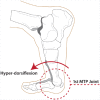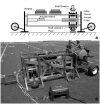The Athletic Shoe in Football
- PMID: 28151702
- PMCID: PMC5349396
- DOI: 10.1177/1941738117690717
The Athletic Shoe in Football
Abstract
Background: Foot and ankle injuries are common in sports, particularly in cleated athletes. Traditionally, the athletic shoe has not been regarded as a piece of protective equipment but rather as a part of the uniform, with a primary focus on performance and subjective feedback measures of comfort. Changes in turf and shoe design have poorly understood implications on the health and safety of players.
Evidence acquisition: A literature search of the MEDLINE and PubMed databases was conducted. Keywords included athletic shoewear, cleated shoe, football shoes, and shoewear, and search parameters were between the years 2000 and 2016.
Study design: Clinical review.
Level of evidence: Level 5.
Results: The athletic shoe is an important piece of protective sports equipment. There are several important structural considerations of shoe design, including biomechanical compliance, cleat and turf interaction, and shoe sizing/fit, that affect the way an athlete engages with the playing surface and carry important potential implications regarding player safety if not understood and addressed.
Conclusion: Athletic footwear should be considered an integral piece of protective equipment rather than simply an extension of the uniform apparel. More research is needed to define optimal shoe sizing, the effect that design has on mechanical load, and how cleat properties, including pattern and structure, interact with the variety of playing surfaces.
Keywords: athletic shoewear; cleated shoe; footwear.
Conflict of interest statement
The following authors declared potential conflicts of interest: Richard Kent, PhD, is a paid consultant for the NFL. Jeff Crandall, PhD, is a paid consultant for the NFL and has grants/grants pending from the University of Virginia. David Lessley, PhD, is a paid consultant for Biocore. Robert B. Anderson, MD, is a paid consultant for Wright Medical, DJO, Zimmer Biomet, Amniox, and Arthrex; receives royalties from Wright Medical, Arthrex, and Zimmer Biomet; and had travel paid for and received an honorarium for committee chairman duties that included this project oversight from the NFL.
Figures






References
-
- ASTMF911-85. Standard Test Method for Flexibility of Running Shoes (Withdrawn 2002). West Conshohocken, PA: ASTM International; 1994.
-
- Benson BW, Hamilton GM, Meeuwisse WH, McCrory P, Dvorak J. Is protective equipment useful in preventing concussion? A systematic review of the literature. Br J Sports Med. 2009;43(suppl 1):i56-i67. - PubMed
-
- Brock E, Zhang S, Milner C, Liu X, Brosnan JT, Sorochan JC. Effects of two football stud configurations on biomechanical characteristics of single-leg landing and cutting movements on infilled synthetic turf. Sports Biomech. 2014;13:362-379. - PubMed
Publication types
MeSH terms
LinkOut - more resources
Full Text Sources
Other Literature Sources
Medical
Research Materials

